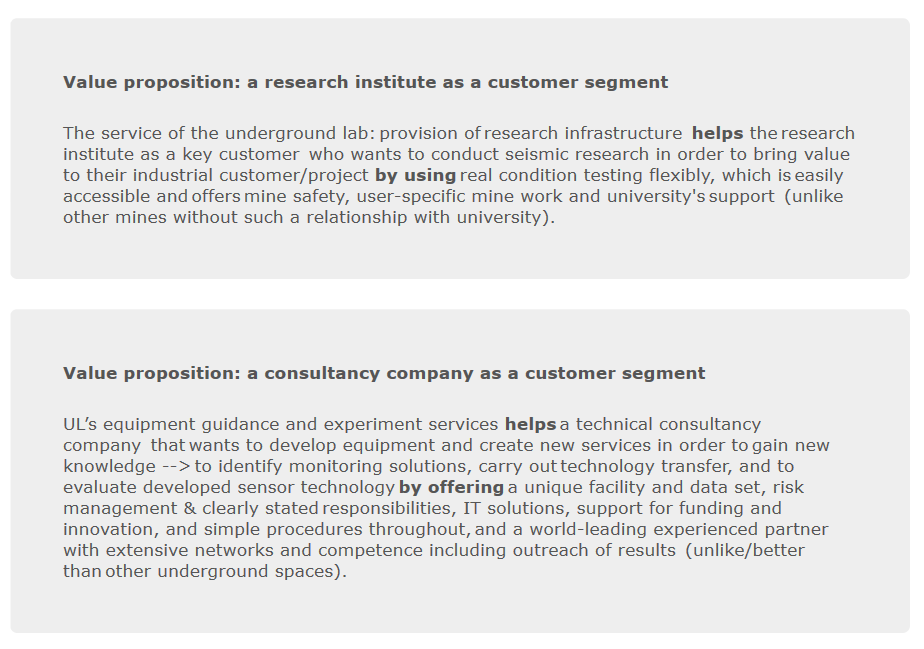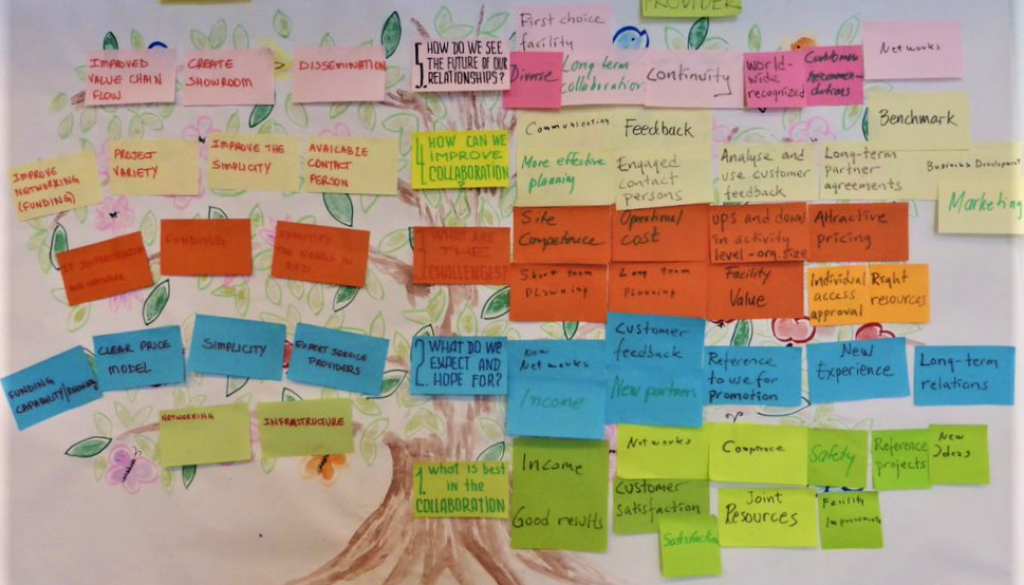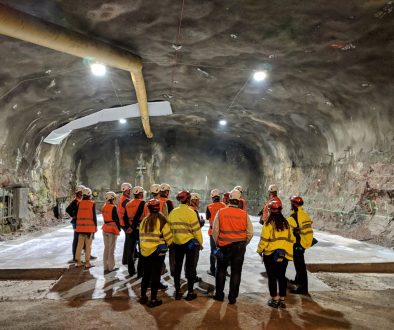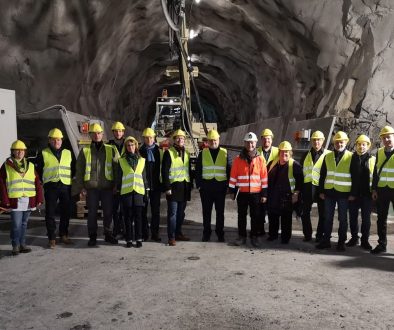Creating value propositions and service offering for the underground labs and their network: Part 2: Creation and reflection
By Aro Päivi, Ahola Helena
In the Baltic Sea region the underground labs have been used mostly for scientific research purposes, e.g. physics. Now the same infrastructure, facilities and the underground related expertise will be used for also business purposes, e.g. SMEs’ innovation work. Oulu University of Applied Sciences’ contribution in the project has been in developing service concepts, value propositions and the service offerings of the underground labs and their network to boost their business capabilities via Service Design methods.
Introduction
The purpose of the paper is to describe the process of creating value propositions and the service offering for the Underground Labs (later UL) and their network within the BSUIN project by using service design as an approach. In addition, the aim is to create a service design concept for that kind of service development. The objective of the BSUIN project is to develop a service offering of Baltic Sea Region’s ULs in order to increase their capability to offer technology transfer utilizing the facilities and research infrastructure of the ULs for business development [1]. Previously the business models of the ULs have been described by the authors [2].
Service design as an approach consists of four stages: exploration, creation, reflection and implementation [3]. In this article we concentrate on the creation and reflection stages (figure 1).

In the service design work package of the BSUIN project the aim is to create a service concept for each UL. Service concept is defined as a shared and articulated understanding of the nature of the service, its delivery and consumption. It is a detailed description of the customer needs to be satisfied [4] [5] [6]. The outputs for the ULs are the value propositions of improved services. Based on these service concepts of the ULs a joint service offering for the network of the ULs was created. Finally, thinking about the whole service development process from the exploration, creation and reflection stages, service design concept is created.
The research questions for the paper are the following:
- How to create service concepts for the ULs?
- How to create a joint service offering the network of ULs based on the unique features of the ULs and the strengths of the network of ULs?
- How to create a service design concept for the network of ULs?
The research process follows the stages of service development (figure 1). The main data of the research consists of the workshop results and it has been analysed qualitatively by using content analysis.
Theoretical background and concepts
In this chapter theoretical framework of the research is introduced shortly with key concepts: professional services, value proposition, customer profile, value map, service offering, and customer journey.
From theoretical point of view, professional services, such as ULs also are, can be characterized by high labor content, high customization and high customer contact. An additional characteristic is the presence of a professionalized workforce, i.e. employees whose knowledge, ethical codes and loyalties may be tied to professional bodies outside of the firm. The distinguishing feature of these services is their knowledge-intensive nature. Services in general and professional services in particular are processes, or journeys, which are experienced differently by different people. [6]
A value proposition has a key role in business strategy, and it is considered a strategic imperative for companies. Thus, value proposition development is a critical strategic issue. It is argued that a competitive advantage in a service-based business depends on its ability to develop a value proposition focusing on the customer’s value-creation needs [7]. A company’s value proposition is defined as the set of benefits or values it promises to deliver to consumers to satisfy their needs [8] and it describes the benefits customers can expect from the products and services of a company [9]. It is a strategic management’s decision on what the company believes its customers value the most and, what it is able to deliver that gives it competitive advantage [10]. It consists of physical/technical enablers that create the conditions for the service experience and includes the functional and emotional benefits of a company’s brand [11].
When developing value propositions for the network and the individual ULs the following viewpoints are important [12]. The nature and composition of value proposition changes as a relationship evolves from conducting a single project toward a more established customer relationship. Individual experts possess a crucial role in that development. Although emotional aspects of value propositions are becoming more important as relationship develops, economic value is still important e.g. constant savings and a competitive price. They are seen as a natural consequence of functioning collaboration, intertwined with functional value components. Understanding the customer’s unique context is important, both in early and later stages of the relationship. However, in new relationships project focused, short-term needs and demands are emphasized. It is important to know the vision, strategy and the business model of the network to be able to cooperate successfully, e.g. [13]. One way of visualizing a business model is through the Business Model Canvas. It has though limitations in cases where several companies and individuals form a network in a new business model [14].
Customer Profile describes the gains, pains and customer jobs. Gains are the benefits which the customer expects and needs, what would delight customers and the things which may increase likelihood of adopting a value proposition. Pains are the negative experiences, emotions and risks that the customer experiences in the process of getting the job done. Customer jobs are the functional, social and emotional tasks customers are trying to perform, problems they are trying to solve and needs they wish to satisfy. A customer profile should be created for each customer segment, as each segment has distinct gains, pains and jobs. [9]
Value Map is the other side of the value proposition canvas (see Figure 2]. The value map describes how value can be created for the customer segment in question. It describes the features of a specific value proposition in the business model and it breaks the value proposition down into products and services, pain relievers and gain creators. [9]
Service offering makes services tangible and concrete by defining and analysing the necessary service components. This is intended to clarify the core structure of the services so that they do not need to be re-invented every time they are provided. Analysing the elements (or components) also enables an understanding of which service elements can be considered to be essential and which of them extra. Those extra elements can either be supporting elements or additional services. The convenience of the essential core service can be enhanced by additional services and supporting services, being particularly useful to distinguish oneself from the competition. Tailoring services to fulfil particular customer needs becomes possible once it is clear which elements are core, supporting or additional. [15]
Customer journey means the sequence of events that customers go through to learn about, purchase and interact with company offerings – including commodities, goods, services or experiences, e.g. [16]. The customer journey canvas can be used as a practical tool, see more, e.g. [17].
Methodology
Service design was used as an approach in the project because it helps to innovate or improve services to make them more useful, usable, desirable for customers and efficient as well as effective for organizations [18]. Applying service design is a novel approach in this context, as its visual tools and customer orientation are believed to benefit such industrial B2B service development. Besides customer orientation, service design emphasises the importance of the lucrativeness of the services being developed for the service provider. Further service design can be viewed as a process and toolset and therefore it provided a framework for us. [19]
As a research approach of this paper, case study strategy was adopted. A case study method explores subjects and issues where relationships may be ambiguous or uncertain, but also attempts to attribute causal relationships; hence, a case study is not merely describing a situation [20]. Data was gathered in service design workshops during 2018–2019 and data was analysed using qualitative methods, mainly content analyses. Service design workshops were facilitated with visual tools, such as value proposition canvas, and other relevant co-design tools in order to gain understanding of the needs of relevant customers as well as the activities of the service providers. The summary of the workshops and the tools used are introduced in the next chapters.
Figure 2 illustrates how the business model and value proposition are linked. The business model and business model canvas are discussed in our previous papers [2] [21]. Value proposition canvas captures the value proposition and has two sides: on the right the customer profile and on the left the value map.

Value proposition analysis tool was used to design the value propositions. The content of the value proposition canvas is formulated into a sentence with that tool (figure 3).

Creating service concepts and value propositions for the Underground labs
Four workshops were arranged with the ULs in order to create the service concepts and the value propositions for them and, the focus of the workshops was decided in close co-operation with each UL. The following questions were addressed as a focus of the workshops:
- What are the key requirements of data storage and managing services when considering the needs of companies and organisations interested in such hypersensitive data center services?
- What are the critical points in the service process of the long-term customers: research institutions?
- How can a research laboratory support geo-measurement companies in their R&D and innovation activities?
- What are the requirements for the companies using underground space as a touristic destination to provide safety for visitors?
For each creation workshop specific service design tools were chosen depending on the focus and context. In these creation workshops the main service design tool was the value proposition canvas (figure 2), because it is at the core of the business model canvas. The other service design tools of the workshops are introduced in the video [22]. The results of each workshop were analysed qualitatively and using a value proposition analysis tool (figure 3) and value propositions were provided for each specific service and a customer segment.
In figure 4 there is a tree which was used in most workshops. The topics or questions are tailored depending on the purpose. In this example there are five questions: What do we expect of the collaboration? What is best in the collaboration? What are the challenges? How can we improve collaboration? How do we see the future of our relationship?

The participants, focus, tools and results of the creation workshops are briefly introduced in table 1.
Name & Date |
Participants |
Focus / question for the workshop |
Tools used in the workshop |
Results in brief |
| Callio
November 2018 |
19 in total
Potential customers and service providers Experts Master students |
What are the key requirements of data storage and managing services when considering the needs of companies and organisations interested in such hypersensitive data center services? | Presentation of Callio´s business concept,
Keynote speech & Context Map Four-fold chart Business Model Canvas |
Context Map – findings
Preliminary service ideas Services for further development Four business models (drafts) SWOT-analysis Recommendations Value proposition
|
| Reiche Zeche
February 2019 |
10 in total
Mining professor, Mine manager, Experts and researchers from the research institutes and projects |
What are the critical points in the service process of the long-term customers: research institutions? | Tree about collaboration and relationship
Value Proposition Canvas
|
SWOT-analysis
Tree about collaboration – results Recommendations Value propositions for research institutes & projects Critical points in the service process Breaking news from the workshop: Recap |
| Äspö
April 2019
|
8 in total Customers
Staff Community representatives Consultants Researchers |
How can Äspö Hard Rock Laboratory support geo-measurement companies in their R&D and innovation activities? | Tree about
collaboration and relationship Value Proposition Canvas Service blueprint |
Tree about collaboration – results
Value propositions for two customer groups Service blueprint SWOT-analysis Recommendations |
| Ruskeala May 2019 | 14 in totalRepresentatives for company Kolmas Plus Representatives from Ministry of Cultural HeritageRepresentatives from Ministry of Natural ResourcesRepresentatives from Geological Institute of Russian Scientific Academy | What are the requirements for the companies using underground space as a touristic destination to provide safety for visitors? | Tree aboutcollaborationFour-fold chart
Interviews |
Preliminary service ideas related to safety for RuskealaSWOT-analysisRecommendations for Kolmas PlusRecommendations for Service ProviderService for Ruskeala (and historical mines for tourism destinations) offered by KRC |
In the creation stage six value proposition were created by the authors based on the results of the workshops. There are two examples (without the name of the underground lab) of the value propositions formulated with the value proposition analysis tool.
 Every underground lab got a report with the results of the workshop, conclusions and recommendation drawn by the authors who facilitated the workshops. Based on all creation workshops some general conclusions and recommendations were made. From the customers’ point of view it is important that the UL is in a stable political society and business environment, its services are reliable, certified, and secured. Customers appreciate physical accessibility, ready-made infrastructure and spaces, stability and predictability, and good data connections. In addition, sustainability and reasonable price are important for them.
Every underground lab got a report with the results of the workshop, conclusions and recommendation drawn by the authors who facilitated the workshops. Based on all creation workshops some general conclusions and recommendations were made. From the customers’ point of view it is important that the UL is in a stable political society and business environment, its services are reliable, certified, and secured. Customers appreciate physical accessibility, ready-made infrastructure and spaces, stability and predictability, and good data connections. In addition, sustainability and reasonable price are important for them.
Creating innovative value propositions includes the ability to translate intangible value propositions into desirable, often more tangible offerings. By using service design methods value propositions can be prototyped early to allow emerging ideas to be shared and modified with users, experts, employees and so on.
Creating a service offering and value proposition for the network of underground labs
In order to clarify the services and to create the joint service offering for the UL network two reflection workshops were arranged in the autumn 2019. The focus of the first workshop was on core, supporting and additional services for the network of the ULs. Service components were analysed and defined to clarify the core structure of the services. It was jointly discussed in online workshops which service elements are essential and which of them extra for the network. In the second workshop essential and extra services for the network of ULs, touchpoints of generic customer journey and characteristics of value proposition. The results both workshops were analysed qualitatively with the content analysis.
The number of participants, focus, tools and results of the reflection workshops are briefly introduced in table 2.
Name &Date |
No ofparticipants |
Focus/question for the workshop |
Tools used in the workshop |
Results |
| Service offering for the UL network with the representatives of ULs
3.10. & 4.10.2019 |
4 | Core/supporting/additional services for the UL network | Online workshop via Skype for Business
Interactive discussion on 7 topics |
Limited number of services for the UL network: essential and extra services.
Some characteristics of value proposition.
|
| Service offering for the UL network with BSUIN partners 16.10.2019 | 7 | Essential and extra services for UL network
Touch points of generic customer journey Characteristics of value proposition |
Online workshop via Skype for Business
Interactive discussion |
The service offering: essential services and extra services.
The stages of the generic customer journey. The central elements of the value proposition. |
The core, supporting and additional services were actively discussed in the first workshop. This kind division appeared to be problematic, e.g. supporting and additional services were difficult to distinguish from each other. The participants preferred a limited number of services and they must be clear. Therefore, it was jointly decided to have a two-fold classification and this was also supported [15]. In the second workshop the essential and extra services were reviewed and reflected. And after the second workshop the facilitators modified the services once again.
The joint service offering for the network of ULs was provided (see figure 5). Basic services are the essential, fundamental, core services, which help the customer to solve the problem. The customer pays for them. Additional services are supporting and extra services that add value to the customer. They add the competitiveness of the offering and distinguish it from other service providers. The additional services are always combined with the basic services and they are never needed alone.

The business model for the network of ULs was jointly created and reflected. The business model is based on the data, results and analyses of all the previous workshops. The development of the business model is described by the authors previously [21].
Generic Customer Journey was jointly created in the workshops by using a canvas [17] and especially the touch points were discussed. The generic customer journey is divided into pre-service, service and post-service period. In figure 6 there is a part of that customer journey.

Based on the creation and reflection stages a generic value proposition for the networks of ULs was created by the authors. It was jointly reflected and modified with the project partners and can be later used for the marketing the network of ULs, e.g. on the website. The essential services of the service offering are included in the value proposition.

Proposition of the service design concept
Finally, thinking about the whole service development process from the exploration, creation and reflection stages, service design concept is created. This can be applied as an approach for developing a joint service offering for the network of ULs (figure 7). This approach was applied as the services of ULs are knowledge-intensive, processes, or journeys, which are experienced differently by different people, e.g. [6]. Developing services is an ongoing process. The idea is that each UL gets value in the network and utilizes it in its unique service offering. We have discussed this in our previous paper and conference display [21].

Conclusions and discussion
The purpose of the paper is to describe the process of creating service concepts with the value propositions and the service offering for the ULs and their network within the BSUIN project by using service design as an approach. In addition, the aim is to create a service design concept for that kind of service development.
To create service concepts, customer needs should be in focus and therefore the framework and the canvas of the value proposition [9] were used. Value propositions were made for all the ULs and their specific customer segments understanding the customer’s unique current context. Further it should be noticed that the customer relationships are not static, but dynamic [12].
To create a joint service offering for the network of ULs based on their unique features and the strengths of the network was a challenging task. In order to clarify the services and to create the joint service offering, service components were analysed and defined as essential and additional services [15]. This description makes the services more concrete and accessible for the customers. Together with the business model(s) and value propositions, the service offering is a base for marketing. The value proposition was also created for the network, and a generic business model of which the value proposition is a very crucial part. A generic customer journey was also done, because service is also seen as a process, e.g. [6]. There are many things to be considered when developing new interdisciplinary networks with multiple collaboration, e.g. [13] [14].
Based on the empirical data of using service design in this kind of development context, a service design concept for the network of ULs is proposed. It is challenging to transform the underground infrastructure into services. This concerns both a single UL and their network. The ULs have not been business-oriented and therefore they should look for new customer segments and create new services. They should also create and describe the business models for the chosen customer segments and services and make the value propositions based on their competitive advantages. Creating innovative value propositions includes the ability to translate intangible value propositions into desirable, often more tangible offerings. By using service design methods value propositions can be prototyped early to allow emerging ideas to be shared and modified with users, experts, employees and so on.
Qualitative research can be assessed with the aspects of credibility, transferability, dependability and confirmability, e.g. [23]. The workshops were recorded, all material was photographed after the workshop, post it notes were kept, and data was analysed shortly after workshops. The workshop participants and especially the representatives of the UL in question were asked to familiarize themselves with the results and interpretations of the workshops. The value proposition for the network of ULs covers the results and findings so far.
In addition, triangulation offers alternative forms that can be used in evaluation [23]. In this case two researchers investigated the empirical materials and cross-checked their interpretations and, conclusion and recommendations were jointly drawn. There was an ample data; the results from the previous work package and data of the workshops, and the project meetings and documents. The project partners and especially the participants of the workshops were asked to comment and evalute the interpretations by the researchers. That was very valuable, because the researcher are not underground experts. Different theories related to services were used to analyse and interpret data.
Service design was chosen as an approach, because it offered a process and toolset for the service development. As it is co-creative and practical with visual tools, it allowed underground experts from different disciplines, e.g physics and geology, to collaborate. The representatives of the ULs were responsible for recruiting relevant stakeholders and especially customers to the workshops. In some cases that was challenging. Service design is a hands-on, quick and collaborative way to work, and that was new to some participants, e.g. in Russia.
This study may have both practical and managerial, and theoretical contributions. In the project the participants have access to the results and many of them have been adopted into use. The proposed service design concept could offer a model for developing services in other similar contexts.
In the future, the project has to decide whether the service offering consists of the existing services or will there be developed a totally new service. In addition, developing the service network requires working on many issues, e. g. strategic, economic, common customer relationships, confidence and flow of information. The partners of the network also have to decide how partners positioned around a business model can be organized into a network-based business model that generates additional value for the core business model and for both the partners and the customers.
When developing value propositions for the network and the individual ULs it is important to take into account the dynamic nature of the business models and value propositions. A customer relationship management (CRM) system could help to increase customer understanding and engagement, and in developing profitable, long-term relationships with key customers, customer segments and other key stakeholders.
Productization of services could increase openness and credibility of the service provider. That would also make services simply and easily accessible for the customers. Customers would appreciate a service concept with a clear pricing model. The ULs should communicate the value proposition, not only the technical value for the customer. They should also make the process and content of the services visible on the website. Marketing should be active (including newsletters), and focus should be on the high quality of the product/service. They should also become active in selling, get references and use them in marketing. Establishing systematic communication practices with their customers and other stakeholders is a necessity.
The service processes of the ULs and the network could be further developed by service blueprinting. The services of the ULs should be described, and the customer journey should be made also tangible for the customers. Critical points in the service process were e.g. increasing unexpected costs, limitations and unexpected restrictions concerning the services underground. That would aid in describing, enabling clear and detailed descriptions of all relevant activities and participants and separating visible and backstage actions. Service blueprints also support the understanding of services, identify potential points of failure in the process and facilitate communication.
Acknowledgements
The authors thankfully acknowledge the financial support and cooperation of the following:
- Interreg Baltic Sea Region programme 2014-2020
- The Underground Labs: Callio Lab, Pyhäsalmi mine (Finland)
- Ruskeala (Russia)
- Khlopin Institute Underground Laboratory (Russia)
- Cuprum, copper mine (Poland)
- Reiche Zeche, TU Freiberg Research and Education mine (Germany)
- Äspö Hard Rock Laboratory, Oskarshamn (Sweden)
- The participants of the workshops
References
[1] Baltic Sea Undergound Innovation Network. Referred 1.6.2020. https://bsuin.eu
[2] Aro, P., Ahola, H. & Vuorela, T. 2019. Creating New Innovation Services for Underground Labs in the Baltic Sea Region via Service Design: Part 1: Exploration. ePooki. Oulun ammattikorkeakoulun tutkimus- ja kehitystyön julkaisut 53. Referred 15.03.2020. http://urn.fi/urn:nbn:fi-fe2019061921339.
[3] Stickdorn, M. & Schneider, J. 2011. This is service design thinking. Basics – Tools – Cases. Amsterdam: BIS Publishers.
[4] Goldstein, S. M.; Johnston, R.; Duffy, J-A.; Rao, J. 2002. The service concept: the missing link in service design research? Journal of Operations Management 20, pp. 121–134.
[5] Johnston, R., and Clark, G. 2001. Service Operations Management. Harlow, UK: Prentice-Hall.
[6] Beltagui, A., Sigurdsson, K., Candi, M. & Riedel, J. 2017. Articulating the service concept in professional service firms. Journal of Service Management, Vol. 28, No 3, pp. 593–616.
[7] Tokman, M. and Beitelspracher, L.S. 2011. Supply chain networks and service-dominant logic: suggestions for future research, International Journal of Physical Distribution & Logistics Management, Vol. 41, No. 1, pp. 197–206
[8] Kotler, P & Armstrong, G, 2014. Principles of Marketing. Boston: Pearson.
[9] Osterwalder, A., Pigneur, Y., Bernarda, G. and Smith, A. 2014. Value Proposition Design: How to Create Products and Services Customers Want. New Jersey: Wiley
[10] Rintamäki, T., Kuusela, H. and Mitronen, L. 2007. Identifying competitive customer value propositions in retailing, Managing Service Quality: An international Journal, Vol. 17, No. 6, pp. 621–634.
[11] Sandström, S., Edvarsson, B., Kristensson, P. and Magnusson, P. 2008. Value in use through service experience, Managing Service Quality, Vol. 18, No. 2, pp. 112–126.
[12] Heikka, E-L and Nätti, S. 2018. Evolving value propositions in knowledge-intensive business services. Journal of Business & Industrial Marketing, 33/8 (2018) 1153–1164, © Emerald Publishing Limited [ISSN 0885-8624] [DOI 10.1108/JBIM-12-2017-0306].
[13] Valkokari,K., Valjakka, T., Hakanen, T., Kupi, E. & Kaarela, I. 2014. Palveluverkoston kehittämisen työkirja. VTT. Helsinki.
[14] Lund, M. & Nielsen, C. 2014. The Evolution of Network-based Business Models Illustrated Through the Case Study of an Entrepreneurship Project. The Journal of Business Models, Vol. 2, No. 1, pp. 105–121.
[15] Harkonen, J., Tolonen, A. and Haapasalo, H. 2017. Service productisation: systematising and defining an offering. Journal of Service Management, Vol. 28 No. 5, 2017, pp. 936–971.
[16] Norton, D.W. and Pine II, B. J. 2013. Using the customer journey to road test and refine the business model. Strategy & Leadership Vol. 41 No. 2, 2013, pp. 12–17.
[17] Create a new Customer Journey Canvas. Referred 3.6.2020. https://canvanizer.com/new/customer-journey-canvas
[18] Moritz, S. 2005. Service Design: Practical Access to an Evolving Field. Köln International School of Design.
[19] Stickdorn, M., Hormess, M., Lawrence, A. & Schneider, J. 2018 This is service design doing. Applying Service Design Thinking in the Real World. A Practitioner’s Handbook. Sebastopol, USA: O’Reilly.
[20] Gray, D. E. (2017). Doing research in the business world. Los Angeles: Sage.
[21] Aro, P., Ahola, H. & Posa, B. 2020. A poster of business models in a scientific conference turned into an online display – a new normal? ePooki asiantuntijablogi 22.6. Oulun ammattikorkeakoulu. Referred 23.6.2020. https://blogi.oamk.fi/2020/06/22/a-poster-of-business-models-in-a-scientific-conference-turned-into-an-online-display-a-new-normal
[22] BSUIN project: How Service Design is used in creating service concepts for ULs. Referred 1.6.2020. https://bsuin.eu/2020/04/01/bsuin-project-how-service-design-is-used-in-creating-service-concepts-for-uls/
[23] Eriksson, P. & Kovalainen, A. 2008. Qualitative Methods in Business Research. London: Sage.
Figure Refences
[1] Figure 2. The Business Model Canvas and the Value Proposition Canvas by Strategyzer. In Strategyzer. The Business Model Canvas. Referred 8.6.2020.https://www.strategyzer.com/canvas/business-model-canvas The Value Proposition Canvas. Referred 8.6.2020 https://www.strategyzer.com/canvas/value-proposition-canvas
[2] Figure 2. The value proposition analysis tool by Strategyzer. In Strategyzer. Ad-Lib Value Proposition Template. Referred 8.6.2020. https://assets.strategyzer.com/assets/resources/ad-lib-value-proposition-template.pdf




